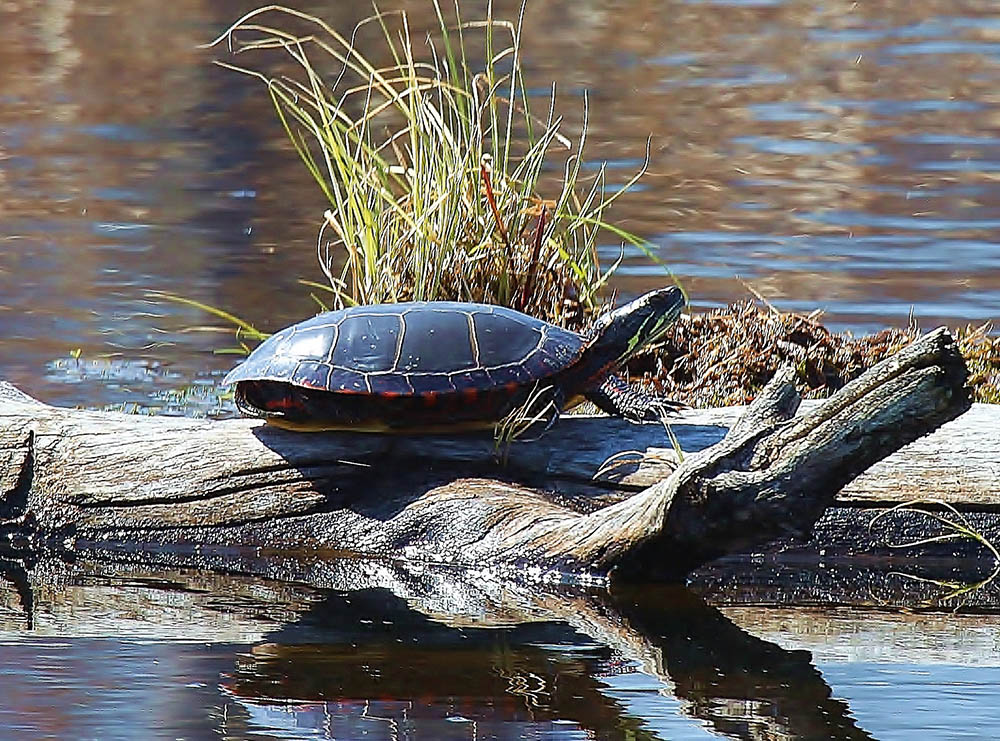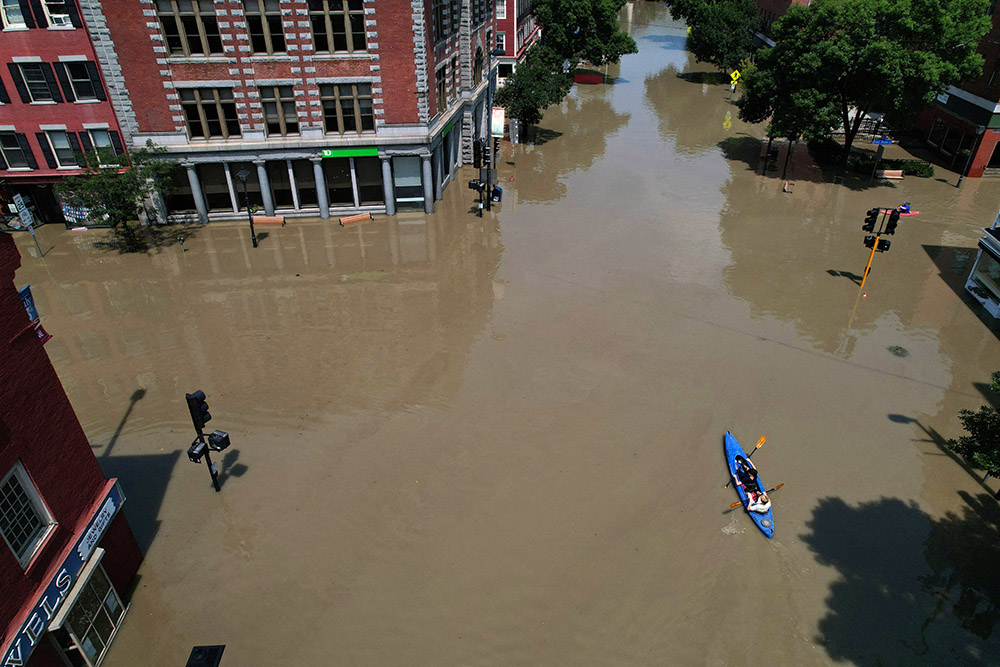
A painted turtle at Missisquoi National Wildlife Refuge in Vermont (Flickr/U.S. Fish and Wildlife Service Northeast Region/Ken Sturm)
Vermont survived the July 2023 flooding. Now we need to tell a new creation story.
In the aftermath of the flooding from a storm that dropped as much as 9 inches of rain in 48 hours, our community has been inundated with a different kind of flood.
Coverage of the event in major national media has been proclaiming that Vermont, the land already populating with self-identified climate refugees, is not beyond the environmental apocalypse. In some reports, one can detect an undercurrent of schadenfreude aimed at a small state that had become famous for its environmental leadership, and no small amount of bragging about its ecological and social justice accomplishments.
While physical events shattered our material infrastructure, this new inundation — the news cycle — is shaking our emotional and spiritual foundations.
Add into this mix a summer of serious air pollution from Canadian wildfires. Then recall that we are still emerging from the long social isolation and fears that COVID-19 brought, amid yet another uptick in recorded cases nationally.

People paddle a kayak on a flooded street in Montpelier, Vermont, on July 11. (OSV News/Reuters/Brian Snyder)
It is no wonder that many are using apocalyptic language. Beneath the dark humor of comments like, "What next in Vermont, will it begin raining frogs?", one now hears open expressions that the Creator and Mother Earth are punishing us for the harm we have inflicted on the planet. More young people, both here in one of the fastest-aging states in the U.S. and globally, are expressing doubts about bringing children into a world that they are increasingly convinced is on the way out.
Certainly, the 2023 Vermont flood is a sign of climate imbalance and turbulence. And we cannot help but wonder if humanity can gather the momentum needed to turn the ship.
To accomplish this feat, we will need to be inspired by stories of creation and re-creation. The Native American Anishinaabe creation story of Turtle Island, which is not identified with any mainstream religious denomination, is a neutral ground to begin such new and probing discussions.
In every version of the Turtle Island story, a human progenitor struggles to cope with a flood or alien watery environment and is aided by a large number of other-than-human kin who attempt, but fail, to bring soil from watery depths so that life can begin anew.
Advertisement
Finally, Muskrat brings life-giving soil to the surface in a self-sacrificing action. Precious soil is placed on Turtle's back, where it expands to form a livable space called Turtle Island, which is also known today as North America.
For Native Americans, this is both a parable and a set of foundational teachings: Humans wouldn't be here without the freely offered gifts of all the beings that precede and surround us. And we cannot stay here — let alone flourish — without responding with gratitude and living in harmony with the beings that give us life.
Turtle Island's message is what the Vermont floods now call us to embrace: to make reciprocal kinship with all beings the central, defining cultural value of our pluralist society. To start with the principle that we don't possess the land, the land possesses us.
Potawatomi author Robin Wall Kimmerer, in her New York Times bestseller Braiding Sweetgrass: Indigenous Wisdom, Scientific Knowledge and the Teachings of Plants, calls this act of deeply reconnecting with the Earth "becoming naturalized to place." Indigenous peoples learned to live in their ancestral lands by listening to their elder sisters and brothers, the plants and animals around them, something non-Indigenous people can learn to do, too.
Kimmerer notes that becoming "naturalized to place" is a call to "throw off the mindset of the immigrant" and "to live as if this is the land that feeds you, as if these are the streams from which you drink, that build your body and feed your spirit."
"To become naturalized is to live as if your children's future matters, to take care of the land as if our lives and the lives of all our relatives depend on it. Because they do," she says.
Given the environmental challenges we face, returning to authentic kinship with the Earth will be a long journey. We may feel like we are facing an uncertain reception. In this, we are not unlike the story of the prodigal son that Jesus tells in the Gospel of Luke.
Rather than wait for the rich father to die, the son asks for his inheritance and disappears into the city. He lives in luxury and self-indulgence until he wakes up in poverty, starving, and with no option other than to humble himself and return home. Hoping to be accepted back as a mere servant, the lost son is welcomed back without qualification by a father who is so overjoyed that he holds a feast.
The flood offers us the opportunity to turn around, go home, ask for forgiveness, and most importantly, begin the process of healing ourselves and the planet.
In a similar way, modern, Western societies — and now most societies — have asked for our inheritance, even demanded or seized it, from the Earth. We've lived foolishly and squandered it, sometimes unknowingly but often fully conscious of the risks, until we now quite literally find ourselves mired in mud.
The flood offers us the opportunity to turn around, go home, ask for forgiveness, and most importantly, begin the process of healing ourselves and the planet. From the perspective of the Turtle Island story, the Earth and her beings are like the prodigal son's father: not only willing to forgive us as a repentant servant, but also to embrace us as a beloved child.
This shift may sound daunting, but from our joint perspective as a Native American non-Christian environmentalist and non-Indigenous Catholic theologian, the distance is smaller than we once thought. Together, we are discovering that the foundational stories of Christianity and Indigenous people have much in common.
Pope Francis's 2015 encyclical "Laudato Si', on Care for Our Common Home," his references to the teachings of St. Francis of Assisi, and the 2022 film "The Letter," which features Indigenous voices, all build bridges between worldviews once thought to be disconnected, if not adversarial.
The Vatican's 2023 repudiation of The Doctrine of Discovery, long misunderstood as a license to dominate the people and nature of the Western Hemisphere, has contributed enormously to the possibilities of building on common teachings.
What will conforming ourselves to the Earth look like on the ground? It will be different in different places because it must flow out of the land you live on.
In Central Vermont, it will mean finding a holistic way to give our rivers more space. Interestingly, this isn't an innovation but a return to what both the original Indigenous inhabitants and the first settlers understood. Our early histories record that the greatest archaeological evidence was found in the less flood-prone area of East Montpelier and that the first Europeans envisioned the town growing in the highlands.
Most directly and universally, conforming to the Earth will look something like the shift that occurs when one falls in love — whether with a partner, a new child, or the mother that you return to after years of dissipation — and it becomes the most important relationship among the many that make up who you are.
The Earth and the Spirits have been inviting us into this relationship for a long time. Now, this is the story we need to tell.






